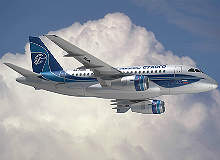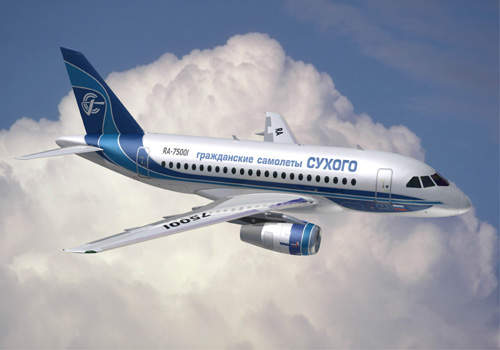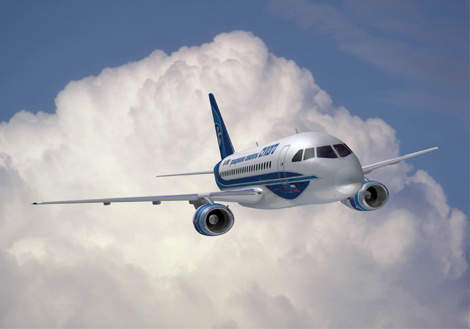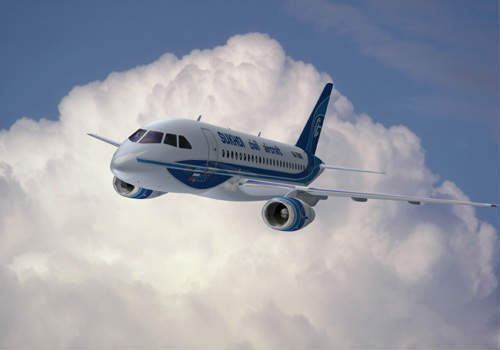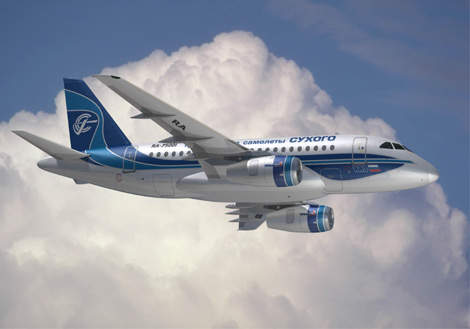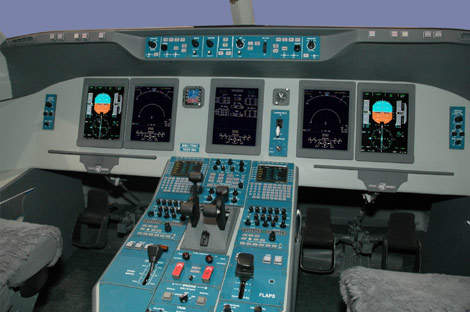The Sukhoi Civil Aircraft Company (AVPK Sukhoi) announced the Russian Regional Jet (RRJ) programme in June 2001. Sukhoi was responsible for design and manufacture of the aircraft. The Russian Aviation and Space Agency (Rosaviakosmos) and the Boeing Company agreed the joint development and marketing of the Russian Regional Jet and Sukhoi, Ilyushin and Boeing formally signed a joint industrial agreement in July 2001.
Ilyushin was responsible for certification of the aircraft. Boeing has been responsible for marketing activities (including sales and leasing) and after sales support (including operational logistics support, maintenance and spares). The aircraft was renamed the Sukhoi Superjet 100 in July 2006.
In March 2003, Rosaviakosmos announced the Russian Government’s selection of the Sukhoi RRJ to meet an initial build for 200 regional jets.
First flights of the Superjet 100
The 95-seat Superjet 100 was rolled out in September 2007 at the KnAAPO assembly plant in Komsolmosk-on-Amur, Siberia. First flight of the aircraft took place in May 2008. A second aircraft entered the flight test programme with first flight in December 2008. A third aircraft made its flight test in July 2009.
On 10 September 2009, the aircraft began the high-altitude test trials and successfully completed them on 23 September 2009. The aircraft achieved initial Russian certification in April 2009 and received the official certification from the Russian Interstate Aviation Committee Aviation Register in February 2011. The type certificate from the European Aviation Safety Agency (EASA) was received in 2012.
Superjet 100 orders and deliveries
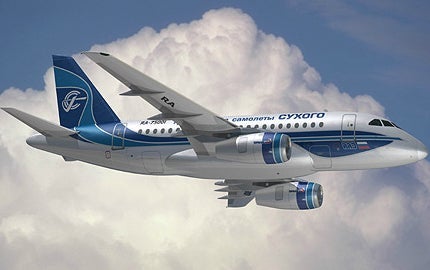
In June 2001, the Sukhoi Civil Aircraft Company (AVPK Sukhoi) announced the Russian Regional Jet (RRJ) programme.
Firm orders have been received for 122 aircraft plus 56 options from customers including: Aeroflot (30 plus 15 options), Kartika Airlines (15 plus 15 options), Sibir Airlines (50), Concord Aviation (20 plus 20), Dalavia Far East Airways (six), AirUnion (30), Interjet (15 plus five options), Armavia (two plus two), ItAli Airlines (10 plus 10) and Avialeasing Aviation Company (24 plus 16 options). In July 2008, Superjet International announced a firm order for five aircraft from Asset Management Advisors (AMA) of Switzerland. Avialeasing ordered 24 aircraft in July 2009.
At the 2009 Paris Air Show, where the plane made its premiere flight, Hungarian national carrier Malev Airlines signed a statement of intent to purchase 30 Superjet 100 for €710m.
In September 2007, Sukhoi and Alenia Aeronautica set up a joint venture company, Superjet International. The company is owned 51% by Alenia and 49% by Sukhoi and is responsible for marketing and support of the aircraft in the West. A completion and delivery centre is located in Venice, Italy.
In July 2012, Interjet converted its five options under a contract signed in January 2011 into firm orders. All the five aircraft were delivered by February 2014.
The first aircraft was delivered to Armavia in April 2011. In June 2011, the aircraft entered commercial operations with Aeroflot. Aeroflot received sixth full-specification SSJ 100 aircraft in February 2014.
PT Sky Aviation placed a $379.2m order for 12 Sukhoi Superjet 100/95B aircraft in June 2011.
In June 2011, Italian Blue Panorama Airlines placed $370m order for 12 SSJ100 aircraft.
In October 2011, SuperJet International received a $200m order from Comlux The Aviation Group for two Sukhoi Business Jets (SBJ) plus two options. Deliveries are scheduled to take place in 2014.
In June 2012, Transaero Airlines placed a $566.4m contract for six Sukhoi Superjet 100/95B aircraft plus 10 options.
Variations of Sukhoi Superjet 100 aircraft
The normal seating configuration is three plus two in economy class and two plus two in business class.
B/E Aerospace in Florida has designed the cabin layouts including the sidewall and ceiling configurations, baggage bins, passenger service panels, reading lights, crew and passenger oxygen systems, seats, services and cabin management systems.
The Superjet 100-75 and -95 variants seat up to 78 and 98 passengers. Both variants are to be built in standard and long range versions.
The Superjet 100 has maximum cruise speed of Mach 0.81 and maximum altitude of 12,500m. The range of the Superjet 100-95 is 3,279km and 4,620km in the Superjet 100-95LR version.
The Superjet 100-95 was the first aircraft built. The aircraft variants have maximum commonality in design, for example in structural design, system fits, avionics, landing gear, electrical systems and power systems.
The Superjet 100-75 seats up to 78 single class passengers. For airlines with a two-class passenger requirement, an alternative configuration provides eight passenger seats in the forward first-class cabin section and 62 tourist-class seats in the main passenger cabin. The cabin has two passenger doors on the port side and three service doors for fast embarkation and disembarkation and fast turnaround at the airport terminal.
There are underfloor baggage hold compartments in the lower section of the fuselage beneath the rear and forward cabins. The baggage compartment volume in the RRJ-75 is 16.1m³.
The Superjet 100-95, overall length 30m, is a stretched version of the baseline Superjet 100-75 with two additional plugs in the fuselage sections forward and aft of the wing. There is also scope for the future development of VIP and cargo versions of the SSJ 100.
A business jet version of the aircraft was announced in June 2011. It is available in the VIP, corporate and government configurations.
Sukhoi Superjet 100 design
Novosibirsk Aircraft Production Association (NAPO), a member of the Sukhoi Holding, manufactures about 40% of the RRJ, including the nose section, vertical and horizontal tail surfaces and the auxiliary power unit.
The Komsomolsk-on-Amur Aircraft Production Association (KnAAPO), also a member of the Sukhoi Holding, manufactures the low swept back wings. RRJ final assembly takes place in Komsomolsk-on-Amur.
The Superjet 100 airliner conforms to ground noise level requirements under ICAO Chapter 4 and FAR 36 Section 4 standards.
In March 2005, Sogitech of France and Sukhoi Civil Aircraft signed an agreement to jointly develop the specifications for creating interactive electronic technical publications for through life after-sales support.
Flight deck and avionics suite supplied by Thales
In June 2005, Thales announced its selection by Sukhoi and the award of a contract to provide the avionics suite for the new Superjet 100 aircraft. The flight deck is of similar design to that on the Airbus A380 aircraft. The avionics suite includes the cockpit displays, communication, navigation and surveillance systems. CMC Electronics is the supplier for the CMA-9000 flight management system (FMS).
Leibherr Aerospace, based in Toulouse, and the Voscod Design Centre in Russia are responsible for the RRJ’s flight control system.
Leibherr is also developing the air control and conditioning system.
SaM146 turbofan engines
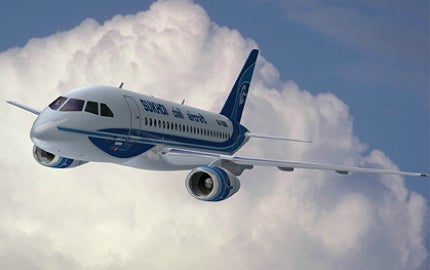
Snecma Moteurs and NPO Saturn have set up a joint venture, Powerjet, to produce the SaM146 turbofan engines.
The Sukhoi RRJ is powered by two podded engines mounted under the wings. Snecma Moteurs and NPO Saturn have set up a joint venture, Powerjet, to produce the SaM146 turbofan engines. Each SaM146 engine is rated at 62kN to 71kN and is fitted with Snecma full authority digital electronic control (FADEC). The engines’ low-pressure system is developed by NPO Saturn.
The Gromov Flight Research Institute signed an agreement with Snecma Moteurs to develop an Ilyushin Il-76 flying testbed for the SaM146 turbofan engines. Flight testing of the engine began in December 2007.
Intertechnique, based in France, is supplying the fuel systems. The aircraft has a fuel capacity of 13,135l.
The aircraft’s auxiliary power supply is designed by Honeywell and MMPP Salyut. The aircraft is equipped with Hamilton Sundstrand electrical systems and Curtiss Wright fire suppressors.
Messier-Dowty retractable landing gear on the Sukhoi Superjet
Superjet 100 is fitted with Messier-Dowty retractable twin-wheeled tricycle-type landing gear with a Sukhoi braking system and Goodrich wheels and brakes. Four-wheel bogies are offered as an option for the main landing gear units.

